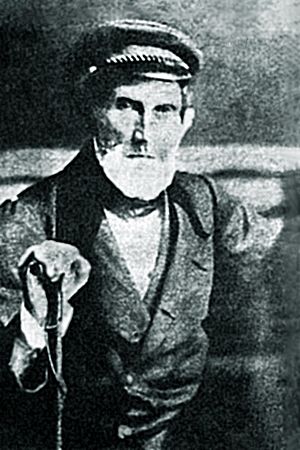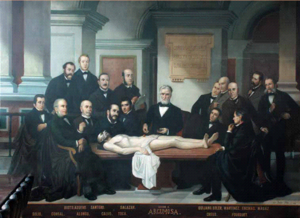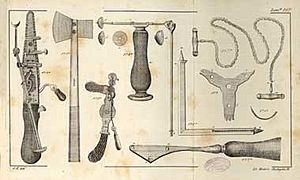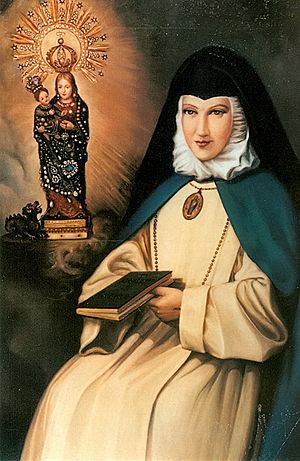Diego de Argumosa facts for kids
Quick facts for kids
Diego de Argumosa
|
|
|---|---|

Diego de Argumosa
|
|
| Born |
Diego de Argumosa y Obregón
July 7, 1792 Villapresente, Cantabria, Spain
|
| Died | April 23, 1865 (aged 72) Torrelavega, Cantabria, Spain
|
| Nationality | Spanish |
| Alma mater | University of Alcalá |
| Occupation | Surgeon |
Diego Manuel de Argumosa y Obregón (born July 7, 1792 – died April 23, 1865) was a famous Spanish doctor. He was known as "the restorer of Spanish surgery" because he brought many new ideas to medicine. He was a professor of surgery at the University of Madrid.
Argumosa was one of the first to use anesthesia (medicine to make you sleep during surgery) in Spain. He introduced ether in 1847. He also ran the first clinical trial, which is like a scientific test for new treatments.
He gained much of his experience during the Peninsular War. He worked as a doctor at the San Rafael Hospital in Santander. Argumosa was also known for helping in a famous case. A Spanish nun named Sor Patrocinio claimed to have stigmata (wounds like those of Jesus).
Argumosa was also involved in politics. He was a member of the Progressive Party. He served as the second mayor of Madrid. He was also a deputy (like a representative) for Madrid in 1836 and 1837. He was asked to be the doctor for Queen Isabel II, but he never accepted the job.
After his family passed away, Argumosa retired at age 62. He moved back to his hometown. He later died in Torrelavega, Cantabria, Spain.
Contents
Early Life and Career
Diego de Argumosa was born on July 7, 1792. His birthplace was Villapresente, in Cantabria, Spain. His parents were both hidalgos, which meant they were from a noble family. His father, Juan Antonio de Argumosa, was also a doctor.
Diego studied at a college in Cantabria. During the Peninsular War, he joined the army as a doctor. He helped wounded soldiers at the San Rafael Hospital in Santander. He also walked with the troops through the mountains. This made his feet hurt and caused him to limp for the rest of his life.
Becoming a Surgeon
When the war ended in 1814, Argumosa earned his first degree. He studied at the University of Alcalá. Later, he went to the Surgical College of San Carlos in Madrid. There, he earned his license to perform surgery.
In 1820, he earned his doctorate degree. His paper was about predicting the outcome of fevers. In 1821, he started teaching as a professor in Burgos. After two years, he returned to Madrid. He became a professor of dissection (studying bodies).
He also took care of his mother and brothers. His father had to leave Spain for political reasons. At first, his teaching followed a French surgeon's ideas. Argumosa later translated that surgeon's book into Spanish. In 1829, he became the head of surgery at the College of San Carlos.
Family Life and Challenges
During these years, he married Micaela Adán. She was the daughter of a famous sculptor. They had three children together. Sadly, his son Diego died when he was only nine years old. He also had two daughters, Isabel and Natalia.
Around 1848, Argumosa had a disagreement with another professor. He felt the professor had written a book based on his classes that was wrong. Later, he wrote articles in a newspaper. He called some professors "university prevaricators." This led to complaints against him.
Argumosa was found not guilty of some charges. But he was found guilty of making insults. He was told to leave Madrid for two years. He also had to pay a fine and could not work or vote during that time.
After his two daughters died close together, Argumosa retired. This was on January 27, 1854. He moved back to Villapresente. He passed away in Torrelavega on April 23, 1865.
Medical Innovations
Diego de Argumosa brought many new ideas to medicine in Spain. He helped change how surgeries were done.
Introducing Anesthesia
On January 13, 1847, Argumosa introduced ether-induced anesthesia to Spain. This was only three months after it was first shown in Boston. He used a cow's bladder with ether inside. Patients would breathe through a metal tube connected to it. Later, he also started using chloroform to make patients sleep.
New Surgical Methods
Argumosa also created new surgical techniques. He also made existing ones better. He changed the patient's position during surgery. He had them lie down instead of sitting up. This helped them handle the pain better.
He developed new ways to amputate (remove) a thigh. He wrote about these methods in his books. He invented a special "basted suture" for treating aneurysms (bulges in blood vessels). He was also one of the first to practice phlebotomy (making a cut in a vein). He would then sew up the tear in the vein.
He also created an intestinal suture. This stitch could leave the body naturally. This meant doctors did not need to make a large cut to remove it.
Improving Patient Care
Some of his new ideas were for general medicine. He was an early user of asepsis. This means taking great care to clean hands, instruments, and the operating room. He also kept patients separate during surgery. He did not operate on them in a room with other patients.
He also made improvements in otorhinolaryngology (ear, nose, and throat medicine). He developed techniques to remove tumors from eyelids and treat lip cancers. He also made the rhinoplasty (nose surgery) technique better. He invented a special type of scalpel called a syringotome.
Urology and Other Fields
In urology (medicine for the urinary system), he had many developments. These included a way to puncture the bladder. He also found different ways to remove kidney stones. He developed methods for urethrotomies (cuts in the urethra). He also used a special knot to tie off varicocele veins.
Argumosa also helped in arthrology (study of joints). His students later built on his work. He started a school of thought. Two of his main students were Juan Creus and Melchor Sánchez de Toca.
In 1854, he retired to write his book, Resumen de Cirugía (Summary of Surgery). It was published in 1856. This book described all the surgical knowledge of his time. It also included all his new ideas. The book had pictures and descriptions of the surgical tools he had created.
The Case of Sor Patrocinio
In 1830, a Spanish nun named Sor Patrocinio said she had stigmata. These were wounds on her hands, feet, and side. She became very famous. Many religious people, from common folk to nobles, visited her convent.
In 1835, Argumosa was one of the doctors asked to study the nun's stigmata. The doctors cleaned and treated her wounds. In less than three weeks, all the wounds healed. The nun was then released from their care. She was later sent away to another town.
Religious and civil leaders agreed that the stigmata were not real. However, some people did not accept Argumosa's medical opinion. During the investigation, a friar (a type of monk) confessed. He said that the nun had given him a special powder. When put on the body, this powder would cause a small sore.
Distinctions
- Member of the National Royal Academy of Medicine (1831)
- Decoration of King Fernand VII (1844)
- Commander of the Royal and Distinguished Spanish Order of Carlos III (1852)
- Member of honor of the Cantabrian Academy of Medicine (1980)
- Academic in the Royal Academy of Sciences and Arts of Barcelona
- Member of the National Academy of Medicine of Mexico
- Member of the Physicians Society of Athens
- Decorated with the Great Cross of Charity
See also
 In Spanish: Diego de Argumosa para niños
In Spanish: Diego de Argumosa para niños




